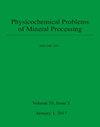The influence of activity coefficient and equilibrium constant models on the speciation of aqueous solutions of H2SO4–MgSO4–Al2(SO4)3 at 235 and 250°C
IF 1.2
4区 工程技术
Q4 CHEMISTRY, PHYSICAL
引用次数: 1
Abstract
Supersaturation occurs in many industrial applications promoting reactive crystallisation between the reactants to form solutes. These solutes accumulate during precipitation, leading to the formation of scales on the inner walls of the reactor and particularly around the stirrer, causing modifications in the hydrodynamics. This encrustation is responsible for process shutdowns in continuous crystallisation processes. Supersaturation control is essential for industrial processes aimed at controlling or inhibiting the formation of these solids. Knowledge of mineral solubility and chemical speciation is required to account for the composition of the complexes in the system in their various solid or aqueous forms. This speciation is obtained by considering the thermodynamic equilibrium constants of the dissociation/complexation reactions involved in the system, the pressure, and the activity coefficients of the chemical species in their molecular or electrolyte form. From these thermodynamic quantities and the state of the system, we can predict the direction of the reaction. This study highlights the risk of the lack of experimental information on equilibrium constants at high temperatures and moderate pressures. Our goal is to evaluate the accuracy of existing models classically used to predict the equilibrium constant in such very hard conditions encountered in hydrometallurgical processes. Furthermore, we demonstrate the influences of equilibrium constants estimation and activity coefficient models on the speciation of H2SO4–Al2(SO4)3–MgSO4 systems, forming hydronium alunite and kieserite in the laterite liquor of hydrometallurgical processes活性系数和平衡常数模型对235和250°C下H2SO4–MgSO4–Al2(SO4)3水溶液形态的影响
过饱和发生在许多工业应用中,促进反应物之间的反应结晶形成溶质。这些溶质在沉淀过程中积累,导致反应器内壁上形成鳞片,特别是在搅拌器周围,引起流体动力学的改变。在连续结晶过程中,这种结壳是导致过程关闭的原因。过饱和控制对于旨在控制或抑制这些固体形成的工业过程是必不可少的。需要了解矿物溶解度和化学形态,以解释系统中各种固体或水形式的配合物的组成。这种形态是通过考虑系统中涉及的解离/络合反应的热力学平衡常数、压力和化学物质在其分子或电解质形式下的活度系数而得到的。根据这些热力学量和系统的状态,我们可以预测反应的方向。这项研究强调了缺乏高温中压平衡常数实验信息的风险。我们的目标是评估在湿法冶金过程中遇到的这种非常困难的条件下,用于预测平衡常数的经典现有模型的准确性。此外,我们论证了平衡常数估算和活度系数模型对湿法冶金红土液中H2SO4-Al2 (SO4) 3-MgSO4体系形成的影响,形成水合明矾石和钾辉石
本文章由计算机程序翻译,如有差异,请以英文原文为准。
求助全文
约1分钟内获得全文
求助全文
来源期刊

Physicochemical Problems of Mineral Processing
CHEMISTRY, PHYSICAL-MINING & MINERAL PROCESSING
自引率
6.70%
发文量
99
期刊介绍:
Physicochemical Problems of Mineral Processing is an international, open access journal which covers theoretical approaches and their practical applications in all aspects of mineral processing and extractive metallurgy.
Criteria for publication in the Physicochemical Problems of Mineral Processing journal are novelty, quality and current interest. Manuscripts which only make routine use of minor extensions to well established methodologies are not appropriate for the journal.
Topics of interest
Analytical techniques and applied mineralogy
Computer applications
Comminution, classification and sorting
Froth flotation
Solid-liquid separation
Gravity concentration
Magnetic and electric separation
Hydro and biohydrometallurgy
Extractive metallurgy
Recycling and mineral wastes
Environmental aspects of mineral processing
and other mineral processing related subjects.
 求助内容:
求助内容: 应助结果提醒方式:
应助结果提醒方式:


